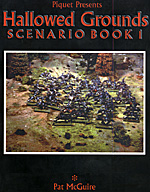
ABOUT THE SCENARIOS
Of the 12 battles presented, 11 are based on real events of the American Civil War. One is based on my own imagination. In some instances I've slightly altered a battlefield or an historic set-up to increase playability. In many cases there were more units listed on official orders of battle than I have included. My rule of thumb was to include only the units that actually participated in the bulk of the fight.
In some other instances I've listed what-if circumstances: reinforcements that could have/should have arrived but didn't. Or didn't until the next day. Most of the scenarios are designed for 4-6 players. Some of those smaller games can be played solitaire.
I designed these scenarios with my 25mm army in mind. Each square on the map equals I square foot on the table. If you're converting to 15mm, assume that each square on the maps equals 8'4". Thus a 4'x8" map in 25mm would come out to 2'10"x5'6". When computing 15mm, range differences, etc, I've used 70% of the 25mm measurements as my rule of thumb.
Each game turn, no matter how long it takes you to play it, takes up 30 minutes of historical battle time (except for Little Roundtop-see scenario 10). Thus when a battle starts at 11:30a.m. and reinforcements are to arrive at 12:30 p.m., they begin entering the board at the start of turn three.
In the Orders of Battle for each scenario, assume that infantry and cavalry regiments contain 4 stands, and that artillery contains 1 stand for every two guns-unless specifically noted otherwise.
I've tried to list the exact type of artillery pieces used in the real-life battle. In some cases, I simply assigned generic smoothbore or rifled tubes. Where the scenario calls for 12# smoothbores, use the 18c M SB Art. Adjustment. Where it calls for 10# rifles, use the 19th c. RML adjustment. You may, of course, substitute any other adjustment of your choice.
I've rated all troops as either militia, regulars or elite, and armed them with muskets (smoothbores) or rifles (Mini rifles; carbines for cavalry). In some cases, I've assigned the unit value out of proportion to the suggested Hallowed Ground formulas, based solely on my historical interpretation of the events. In other cases, to round out the force, I relied on Bob Jones' formula in the Hallowed Ground supplement Card Divisor table (p. 10). If your favorite unit is presented here as militia or regular and you know, in fact, they were elite, go right ahead and make them elite. I won't mind a bit.
I've included some new cards to shuffle into your decks (consult scenarios for details). I've also thought up a few extra optional rules for use with all scenarios.
The Bayonet Rule. Troops that affix bayonets may still fire and load. But with bayonets fixed, it will cost 2 pips per unit firing. Also, add +1 for any unit with fixed bayonets during melee resolution.
The Confederate Cavalry Shotgun Rule. Consider rebel cavalry to be armed with shotguns. This means they can fire from the saddle, at point blank range only, but at a +1 BDV modifier in addition to the standard +1 BDV modifier for point blank. (This can make them deadlier, while mounted, than US cavalry, which may fire carbines from the saddle-see Hallowed Ground supplement-but are considered to have come to a halt and are down 2 die types on a melee resolution card in the current phase.
CSA cavalry that fire at PB before melee resolution, will not drop any BDV level because of the firing.) Note that units termed Mounted Rifles, on either side, are presumed to be firing Minie Rifles and may not fire from the saddle. If this rule seems to favor the CSA too much, simply consider ALL cavalry to be armed with carbines (Early Repeater adjustment on game tables.)
The Buck' n' Ball Rule. Several Confederate regiments were armed with muskets loaded with buck'n'ball ammunition-a regular minie ball plus three roundshot jammed together. At short or point blank range, these units should go up 1 die type on the fire adjustment table.
One final word: this is a war game scenario booklet, a manual to help you get more joy from your toys. It is not a history textbook. There are bound to be quibbles over terrain, placement, troop ratings, even the name of a battle. I make no claim on the title historian. I'm just an overgrown kid who likes to play with little horseymen. Herewith, some humble scrawlings from my alleged mind. May the best man, woman or child, win.
Related
-
One-Drous Chapter: Hallowed Grounds: Scenario 1: First Manassas: Battle of Henry Hill July 21, 1861
One-Drous Chapter: Piquet Master Rules: Designer's Notes
Interview: Bob Jones, Piquet Designer
For More Information
- www.piquet.com
imac100@aol.com
Back to List of One-Drous Chapters: Historical Rules
Back to Master One-Drous Chapters List
Magazine articles and contents are copyrighted property of the respective publication. All copyrights, trademarks, and other rights are held by the respective magazines, companies, and/or licensors, with all rights reserved. MagWeb, its contents, and HTML coding are © Copyright 1998 by Coalition Web, Inc. This article appears in MagWeb (Magazine Web) on the Internet World Wide Web.
Other military history articles and gaming articles are available at http://www.magweb.com